Professional Practice: Family Nurse Practitioner in Primary Care
VerifiedAdded on 2020/10/05
|6
|1371
|99
Report
AI Summary
This report analyzes the role and function of a Family Nurse Practitioner (FNP) within a primary care setting. It addresses interview questions related to the challenges and strategies FNPs employ, including communication, cultural competence, and patient advocacy. The report outlines the types and number of clients FNPs typically serve, along with the professional requirements for advanced nursing roles, such as licensing and certification. Furthermore, it provides a job description of an advanced nurse practitioner, specifically a nurse midwife, and concludes by summarizing key findings and emphasizing the importance of FNPs in healthcare. References include various books, journals, and online resources that support the information presented.
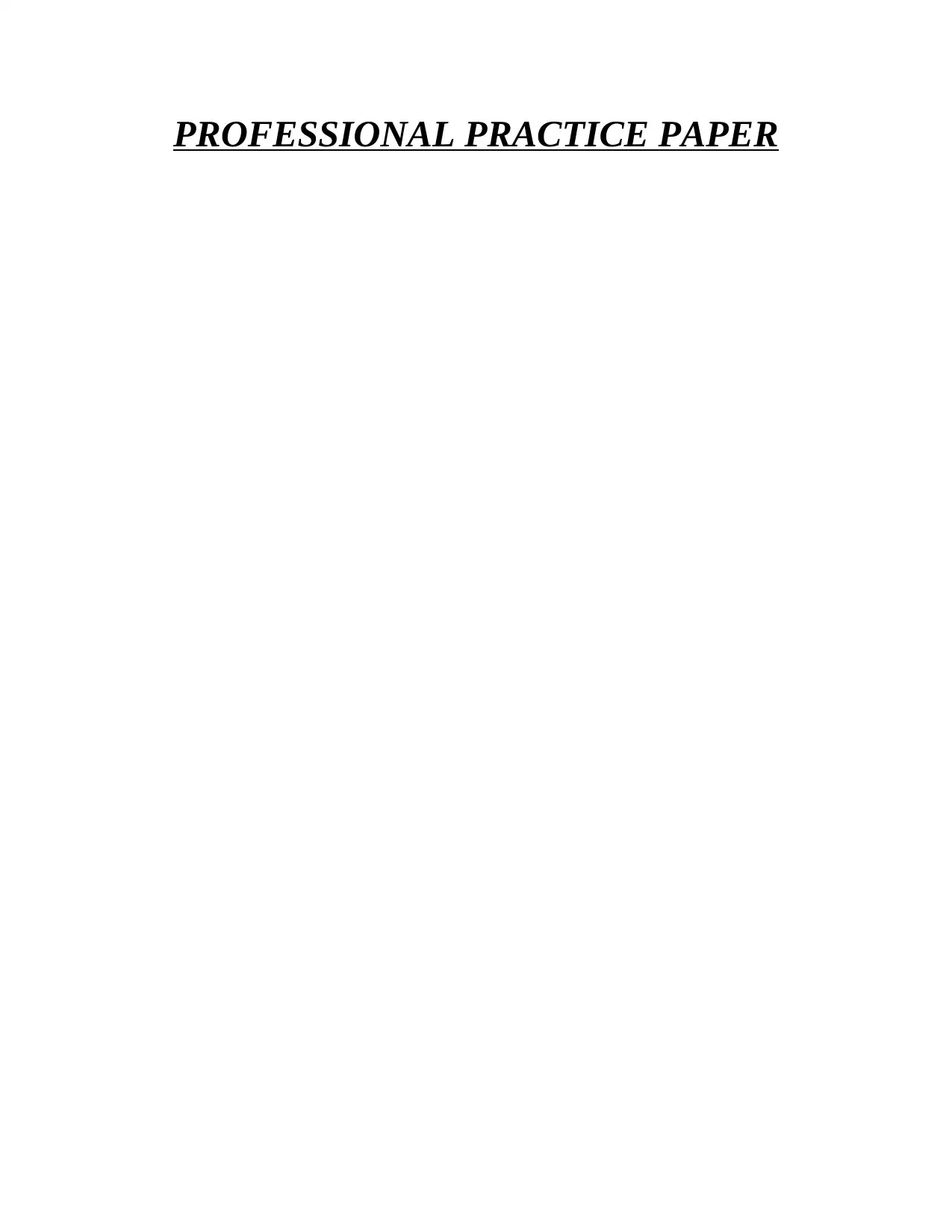
PROFESSIONAL PRACTICE PAPER
Paraphrase This Document
Need a fresh take? Get an instant paraphrase of this document with our AI Paraphraser
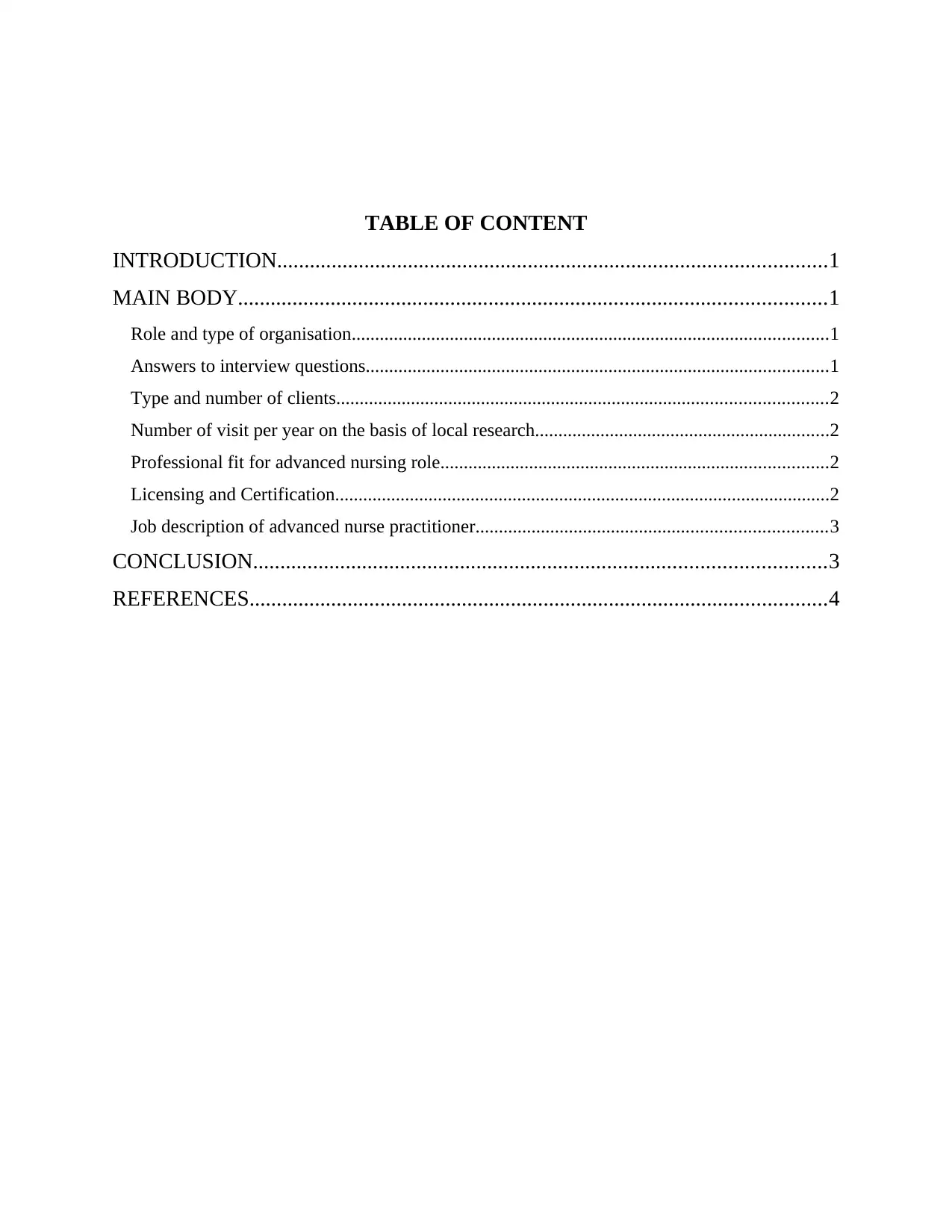
TABLE OF CONTENT
INTRODUCTION.....................................................................................................1
MAIN BODY............................................................................................................1
Role and type of organisation......................................................................................................1
Answers to interview questions...................................................................................................1
Type and number of clients.........................................................................................................2
Number of visit per year on the basis of local research...............................................................2
Professional fit for advanced nursing role...................................................................................2
Licensing and Certification..........................................................................................................2
Job description of advanced nurse practitioner...........................................................................3
CONCLUSION.........................................................................................................3
REFERENCES..........................................................................................................4
INTRODUCTION.....................................................................................................1
MAIN BODY............................................................................................................1
Role and type of organisation......................................................................................................1
Answers to interview questions...................................................................................................1
Type and number of clients.........................................................................................................2
Number of visit per year on the basis of local research...............................................................2
Professional fit for advanced nursing role...................................................................................2
Licensing and Certification..........................................................................................................2
Job description of advanced nurse practitioner...........................................................................3
CONCLUSION.........................................................................................................3
REFERENCES..........................................................................................................4
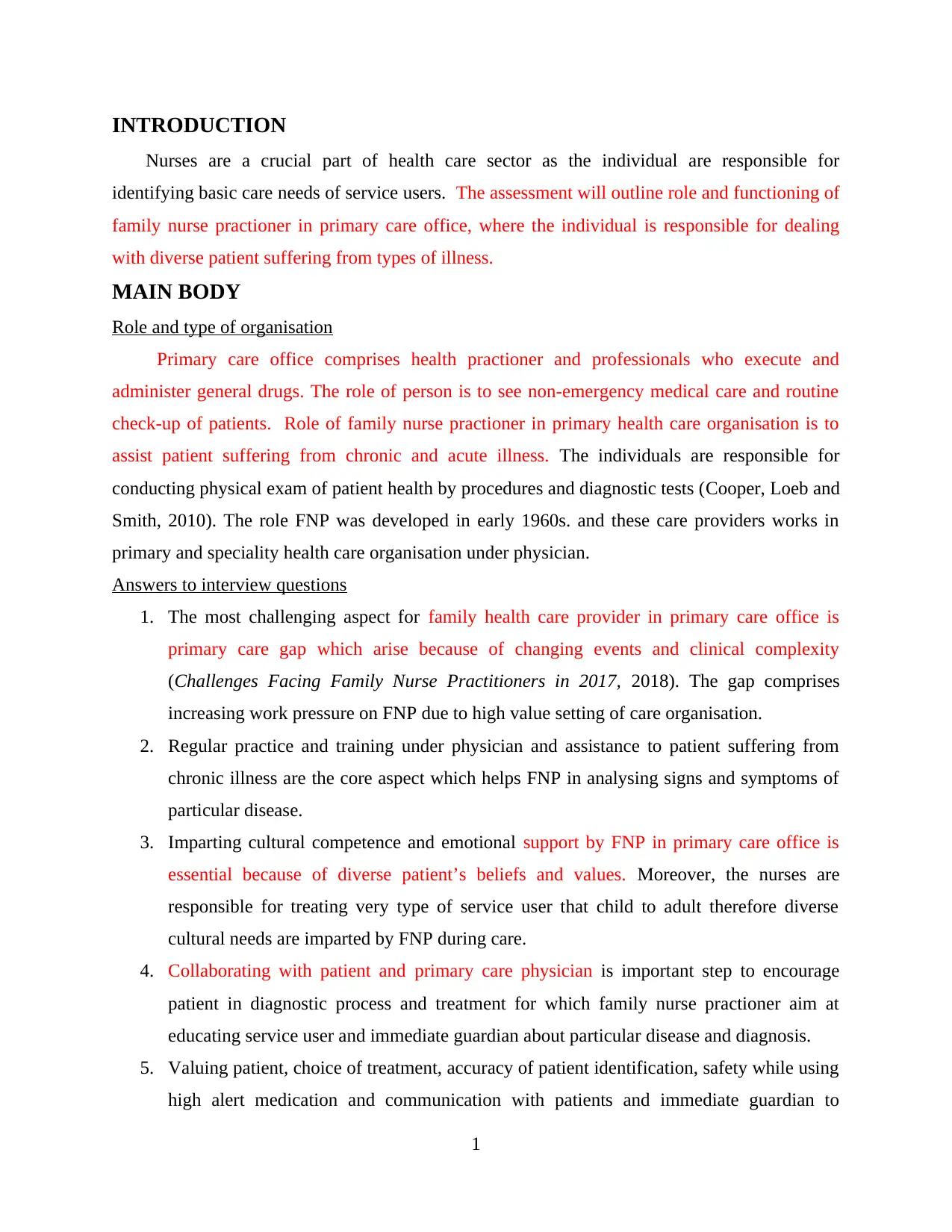
INTRODUCTION
Nurses are a crucial part of health care sector as the individual are responsible for
identifying basic care needs of service users. The assessment will outline role and functioning of
family nurse practioner in primary care office, where the individual is responsible for dealing
with diverse patient suffering from types of illness.
MAIN BODY
Role and type of organisation
Primary care office comprises health practioner and professionals who execute and
administer general drugs. The role of person is to see non-emergency medical care and routine
check-up of patients. Role of family nurse practioner in primary health care organisation is to
assist patient suffering from chronic and acute illness. The individuals are responsible for
conducting physical exam of patient health by procedures and diagnostic tests (Cooper, Loeb and
Smith, 2010). The role FNP was developed in early 1960s. and these care providers works in
primary and speciality health care organisation under physician.
Answers to interview questions
1. The most challenging aspect for family health care provider in primary care office is
primary care gap which arise because of changing events and clinical complexity
(Challenges Facing Family Nurse Practitioners in 2017, 2018). The gap comprises
increasing work pressure on FNP due to high value setting of care organisation.
2. Regular practice and training under physician and assistance to patient suffering from
chronic illness are the core aspect which helps FNP in analysing signs and symptoms of
particular disease.
3. Imparting cultural competence and emotional support by FNP in primary care office is
essential because of diverse patient’s beliefs and values. Moreover, the nurses are
responsible for treating very type of service user that child to adult therefore diverse
cultural needs are imparted by FNP during care.
4. Collaborating with patient and primary care physician is important step to encourage
patient in diagnostic process and treatment for which family nurse practioner aim at
educating service user and immediate guardian about particular disease and diagnosis.
5. Valuing patient, choice of treatment, accuracy of patient identification, safety while using
high alert medication and communication with patients and immediate guardian to
1
Nurses are a crucial part of health care sector as the individual are responsible for
identifying basic care needs of service users. The assessment will outline role and functioning of
family nurse practioner in primary care office, where the individual is responsible for dealing
with diverse patient suffering from types of illness.
MAIN BODY
Role and type of organisation
Primary care office comprises health practioner and professionals who execute and
administer general drugs. The role of person is to see non-emergency medical care and routine
check-up of patients. Role of family nurse practioner in primary health care organisation is to
assist patient suffering from chronic and acute illness. The individuals are responsible for
conducting physical exam of patient health by procedures and diagnostic tests (Cooper, Loeb and
Smith, 2010). The role FNP was developed in early 1960s. and these care providers works in
primary and speciality health care organisation under physician.
Answers to interview questions
1. The most challenging aspect for family health care provider in primary care office is
primary care gap which arise because of changing events and clinical complexity
(Challenges Facing Family Nurse Practitioners in 2017, 2018). The gap comprises
increasing work pressure on FNP due to high value setting of care organisation.
2. Regular practice and training under physician and assistance to patient suffering from
chronic illness are the core aspect which helps FNP in analysing signs and symptoms of
particular disease.
3. Imparting cultural competence and emotional support by FNP in primary care office is
essential because of diverse patient’s beliefs and values. Moreover, the nurses are
responsible for treating very type of service user that child to adult therefore diverse
cultural needs are imparted by FNP during care.
4. Collaborating with patient and primary care physician is important step to encourage
patient in diagnostic process and treatment for which family nurse practioner aim at
educating service user and immediate guardian about particular disease and diagnosis.
5. Valuing patient, choice of treatment, accuracy of patient identification, safety while using
high alert medication and communication with patients and immediate guardian to
1
⊘ This is a preview!⊘
Do you want full access?
Subscribe today to unlock all pages.

Trusted by 1+ million students worldwide
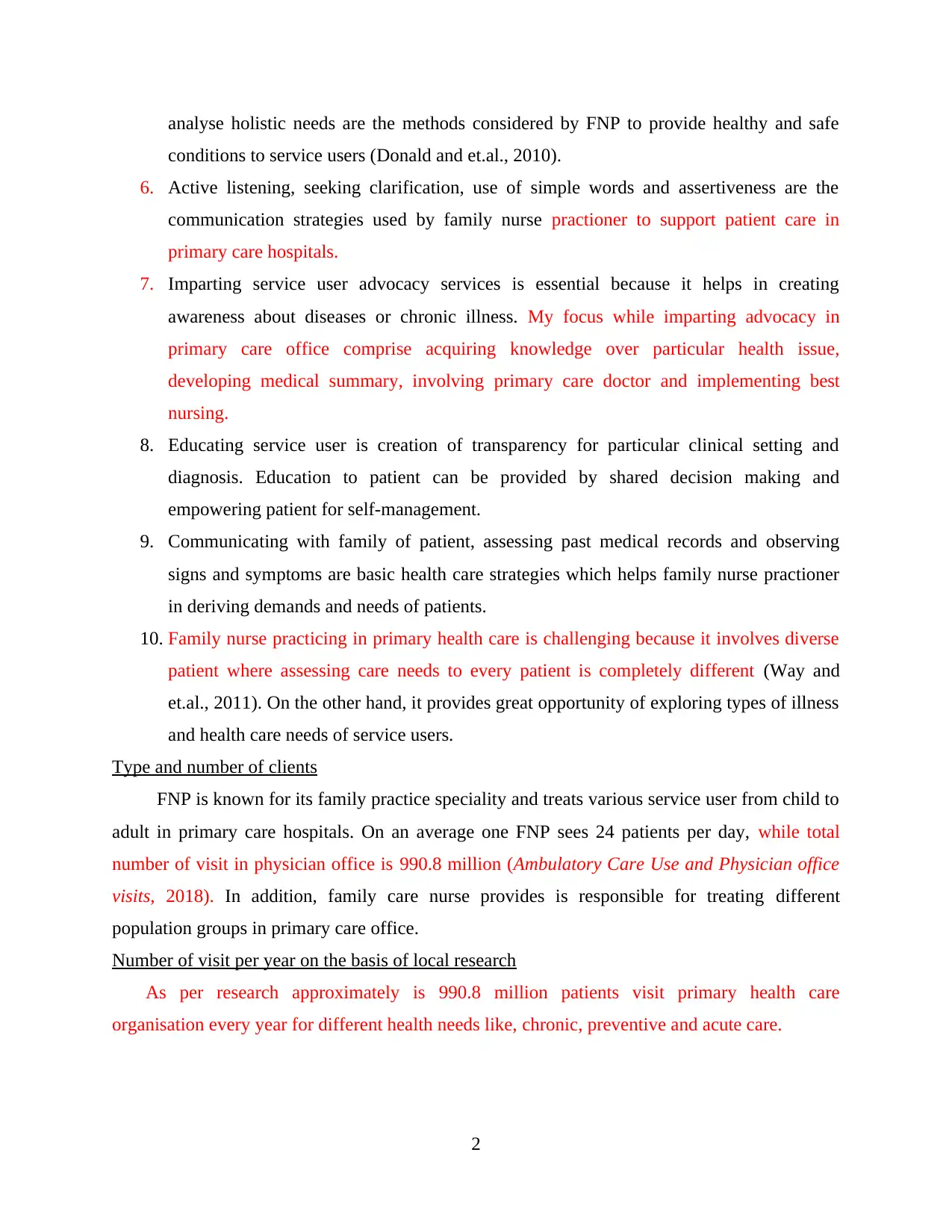
analyse holistic needs are the methods considered by FNP to provide healthy and safe
conditions to service users (Donald and et.al., 2010).
6. Active listening, seeking clarification, use of simple words and assertiveness are the
communication strategies used by family nurse practioner to support patient care in
primary care hospitals.
7. Imparting service user advocacy services is essential because it helps in creating
awareness about diseases or chronic illness. My focus while imparting advocacy in
primary care office comprise acquiring knowledge over particular health issue,
developing medical summary, involving primary care doctor and implementing best
nursing.
8. Educating service user is creation of transparency for particular clinical setting and
diagnosis. Education to patient can be provided by shared decision making and
empowering patient for self-management.
9. Communicating with family of patient, assessing past medical records and observing
signs and symptoms are basic health care strategies which helps family nurse practioner
in deriving demands and needs of patients.
10. Family nurse practicing in primary health care is challenging because it involves diverse
patient where assessing care needs to every patient is completely different (Way and
et.al., 2011). On the other hand, it provides great opportunity of exploring types of illness
and health care needs of service users.
Type and number of clients
FNP is known for its family practice speciality and treats various service user from child to
adult in primary care hospitals. On an average one FNP sees 24 patients per day, while total
number of visit in physician office is 990.8 million (Ambulatory Care Use and Physician office
visits, 2018). In addition, family care nurse provides is responsible for treating different
population groups in primary care office.
Number of visit per year on the basis of local research
As per research approximately is 990.8 million patients visit primary health care
organisation every year for different health needs like, chronic, preventive and acute care.
2
conditions to service users (Donald and et.al., 2010).
6. Active listening, seeking clarification, use of simple words and assertiveness are the
communication strategies used by family nurse practioner to support patient care in
primary care hospitals.
7. Imparting service user advocacy services is essential because it helps in creating
awareness about diseases or chronic illness. My focus while imparting advocacy in
primary care office comprise acquiring knowledge over particular health issue,
developing medical summary, involving primary care doctor and implementing best
nursing.
8. Educating service user is creation of transparency for particular clinical setting and
diagnosis. Education to patient can be provided by shared decision making and
empowering patient for self-management.
9. Communicating with family of patient, assessing past medical records and observing
signs and symptoms are basic health care strategies which helps family nurse practioner
in deriving demands and needs of patients.
10. Family nurse practicing in primary health care is challenging because it involves diverse
patient where assessing care needs to every patient is completely different (Way and
et.al., 2011). On the other hand, it provides great opportunity of exploring types of illness
and health care needs of service users.
Type and number of clients
FNP is known for its family practice speciality and treats various service user from child to
adult in primary care hospitals. On an average one FNP sees 24 patients per day, while total
number of visit in physician office is 990.8 million (Ambulatory Care Use and Physician office
visits, 2018). In addition, family care nurse provides is responsible for treating different
population groups in primary care office.
Number of visit per year on the basis of local research
As per research approximately is 990.8 million patients visit primary health care
organisation every year for different health needs like, chronic, preventive and acute care.
2
Paraphrase This Document
Need a fresh take? Get an instant paraphrase of this document with our AI Paraphraser
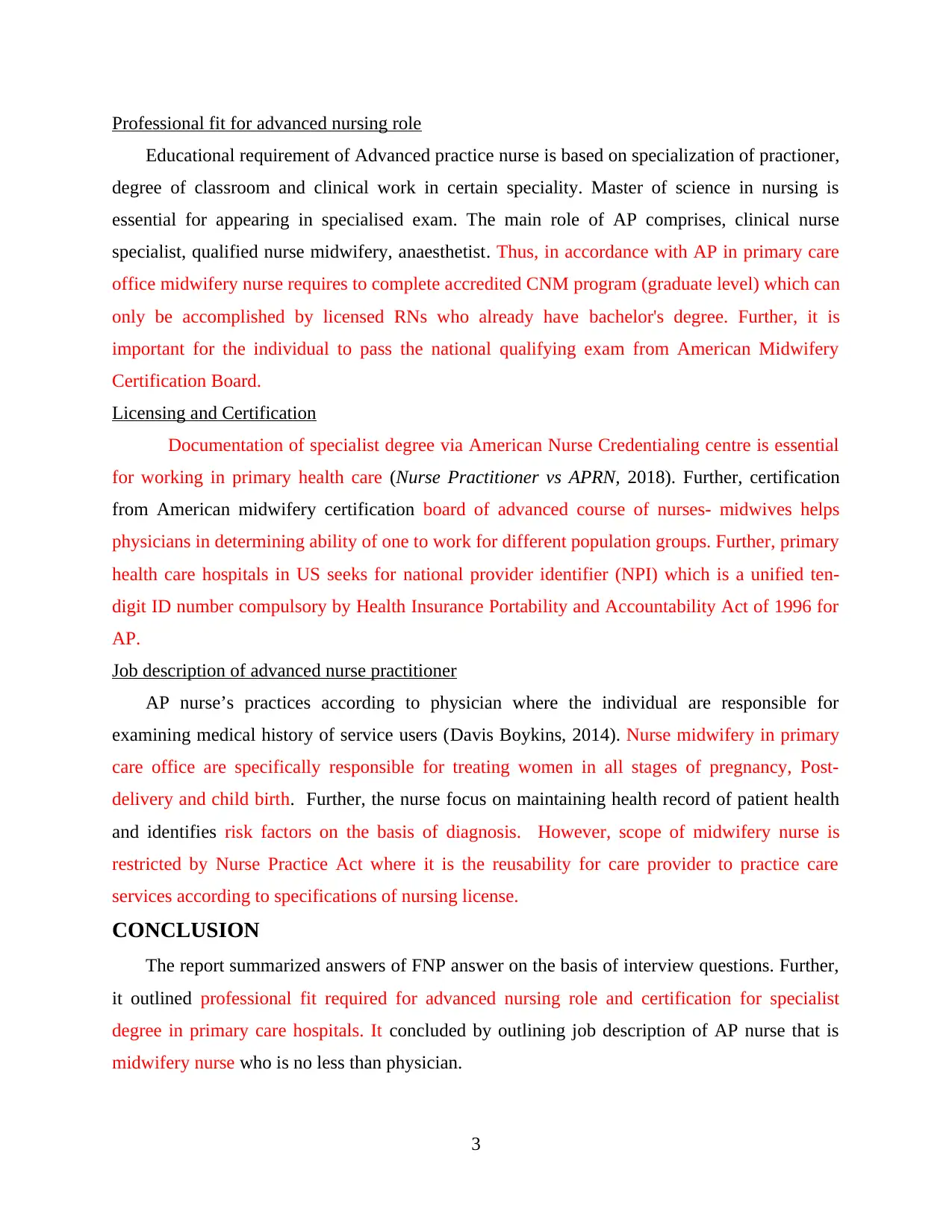
Professional fit for advanced nursing role
Educational requirement of Advanced practice nurse is based on specialization of practioner,
degree of classroom and clinical work in certain speciality. Master of science in nursing is
essential for appearing in specialised exam. The main role of AP comprises, clinical nurse
specialist, qualified nurse midwifery, anaesthetist. Thus, in accordance with AP in primary care
office midwifery nurse requires to complete accredited CNM program (graduate level) which can
only be accomplished by licensed RNs who already have bachelor's degree. Further, it is
important for the individual to pass the national qualifying exam from American Midwifery
Certification Board.
Licensing and Certification
Documentation of specialist degree via American Nurse Credentialing centre is essential
for working in primary health care (Nurse Practitioner vs APRN, 2018). Further, certification
from American midwifery certification board of advanced course of nurses- midwives helps
physicians in determining ability of one to work for different population groups. Further, primary
health care hospitals in US seeks for national provider identifier (NPI) which is a unified ten-
digit ID number compulsory by Health Insurance Portability and Accountability Act of 1996 for
AP.
Job description of advanced nurse practitioner
AP nurse’s practices according to physician where the individual are responsible for
examining medical history of service users (Davis Boykins, 2014). Nurse midwifery in primary
care office are specifically responsible for treating women in all stages of pregnancy, Post-
delivery and child birth. Further, the nurse focus on maintaining health record of patient health
and identifies risk factors on the basis of diagnosis. However, scope of midwifery nurse is
restricted by Nurse Practice Act where it is the reusability for care provider to practice care
services according to specifications of nursing license.
CONCLUSION
The report summarized answers of FNP answer on the basis of interview questions. Further,
it outlined professional fit required for advanced nursing role and certification for specialist
degree in primary care hospitals. It concluded by outlining job description of AP nurse that is
midwifery nurse who is no less than physician.
3
Educational requirement of Advanced practice nurse is based on specialization of practioner,
degree of classroom and clinical work in certain speciality. Master of science in nursing is
essential for appearing in specialised exam. The main role of AP comprises, clinical nurse
specialist, qualified nurse midwifery, anaesthetist. Thus, in accordance with AP in primary care
office midwifery nurse requires to complete accredited CNM program (graduate level) which can
only be accomplished by licensed RNs who already have bachelor's degree. Further, it is
important for the individual to pass the national qualifying exam from American Midwifery
Certification Board.
Licensing and Certification
Documentation of specialist degree via American Nurse Credentialing centre is essential
for working in primary health care (Nurse Practitioner vs APRN, 2018). Further, certification
from American midwifery certification board of advanced course of nurses- midwives helps
physicians in determining ability of one to work for different population groups. Further, primary
health care hospitals in US seeks for national provider identifier (NPI) which is a unified ten-
digit ID number compulsory by Health Insurance Portability and Accountability Act of 1996 for
AP.
Job description of advanced nurse practitioner
AP nurse’s practices according to physician where the individual are responsible for
examining medical history of service users (Davis Boykins, 2014). Nurse midwifery in primary
care office are specifically responsible for treating women in all stages of pregnancy, Post-
delivery and child birth. Further, the nurse focus on maintaining health record of patient health
and identifies risk factors on the basis of diagnosis. However, scope of midwifery nurse is
restricted by Nurse Practice Act where it is the reusability for care provider to practice care
services according to specifications of nursing license.
CONCLUSION
The report summarized answers of FNP answer on the basis of interview questions. Further,
it outlined professional fit required for advanced nursing role and certification for specialist
degree in primary care hospitals. It concluded by outlining job description of AP nurse that is
midwifery nurse who is no less than physician.
3
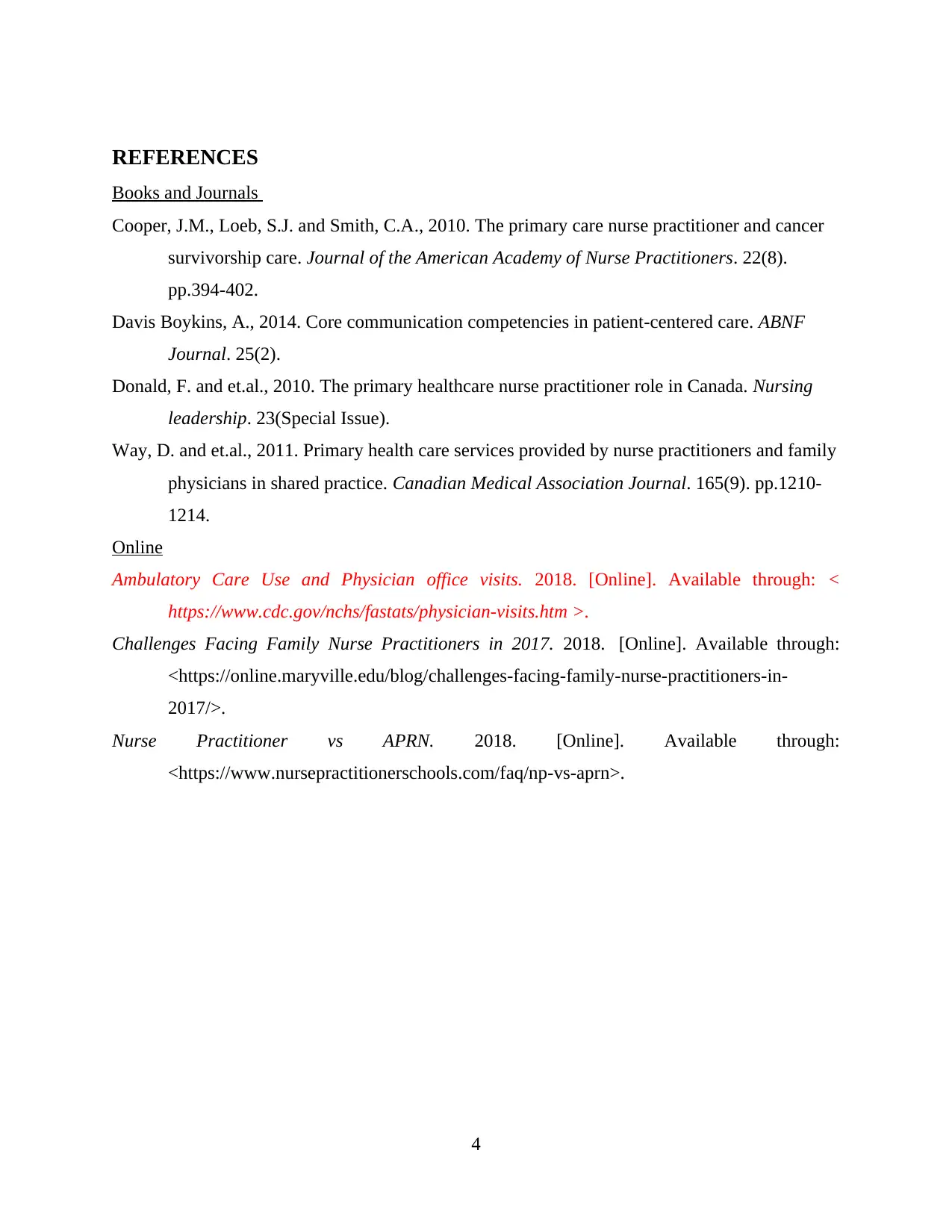
REFERENCES
Books and Journals
Cooper, J.M., Loeb, S.J. and Smith, C.A., 2010. The primary care nurse practitioner and cancer
survivorship care. Journal of the American Academy of Nurse Practitioners. 22(8).
pp.394-402.
Davis Boykins, A., 2014. Core communication competencies in patient-centered care. ABNF
Journal. 25(2).
Donald, F. and et.al., 2010. The primary healthcare nurse practitioner role in Canada. Nursing
leadership. 23(Special Issue).
Way, D. and et.al., 2011. Primary health care services provided by nurse practitioners and family
physicians in shared practice. Canadian Medical Association Journal. 165(9). pp.1210-
1214.
Online
Ambulatory Care Use and Physician office visits. 2018. [Online]. Available through: <
https://www.cdc.gov/nchs/fastats/physician-visits.htm >.
Challenges Facing Family Nurse Practitioners in 2017. 2018. [Online]. Available through:
<https://online.maryville.edu/blog/challenges-facing-family-nurse-practitioners-in-
2017/>.
Nurse Practitioner vs APRN. 2018. [Online]. Available through:
<https://www.nursepractitionerschools.com/faq/np-vs-aprn>.
4
Books and Journals
Cooper, J.M., Loeb, S.J. and Smith, C.A., 2010. The primary care nurse practitioner and cancer
survivorship care. Journal of the American Academy of Nurse Practitioners. 22(8).
pp.394-402.
Davis Boykins, A., 2014. Core communication competencies in patient-centered care. ABNF
Journal. 25(2).
Donald, F. and et.al., 2010. The primary healthcare nurse practitioner role in Canada. Nursing
leadership. 23(Special Issue).
Way, D. and et.al., 2011. Primary health care services provided by nurse practitioners and family
physicians in shared practice. Canadian Medical Association Journal. 165(9). pp.1210-
1214.
Online
Ambulatory Care Use and Physician office visits. 2018. [Online]. Available through: <
https://www.cdc.gov/nchs/fastats/physician-visits.htm >.
Challenges Facing Family Nurse Practitioners in 2017. 2018. [Online]. Available through:
<https://online.maryville.edu/blog/challenges-facing-family-nurse-practitioners-in-
2017/>.
Nurse Practitioner vs APRN. 2018. [Online]. Available through:
<https://www.nursepractitionerschools.com/faq/np-vs-aprn>.
4
⊘ This is a preview!⊘
Do you want full access?
Subscribe today to unlock all pages.

Trusted by 1+ million students worldwide
1 out of 6
Related Documents
Your All-in-One AI-Powered Toolkit for Academic Success.
+13062052269
info@desklib.com
Available 24*7 on WhatsApp / Email
![[object Object]](/_next/static/media/star-bottom.7253800d.svg)
Unlock your academic potential
Copyright © 2020–2025 A2Z Services. All Rights Reserved. Developed and managed by ZUCOL.





